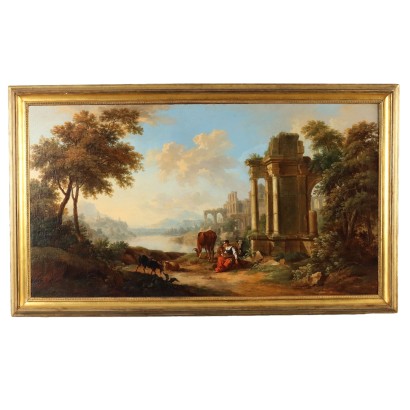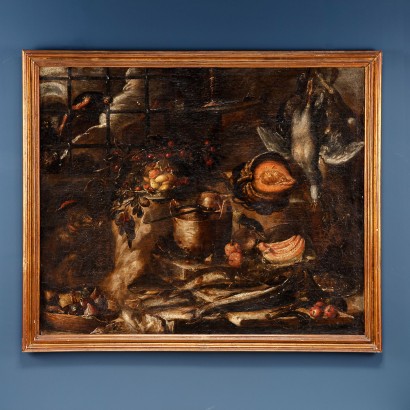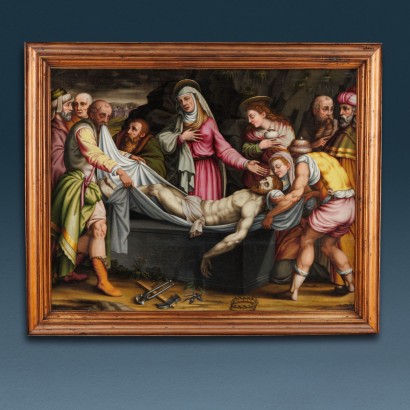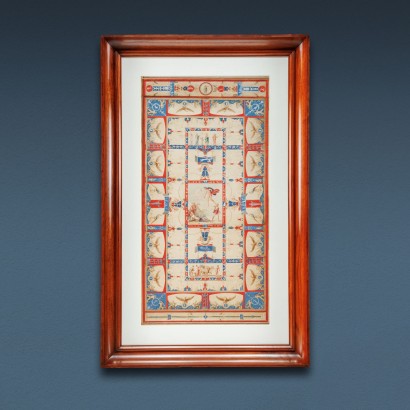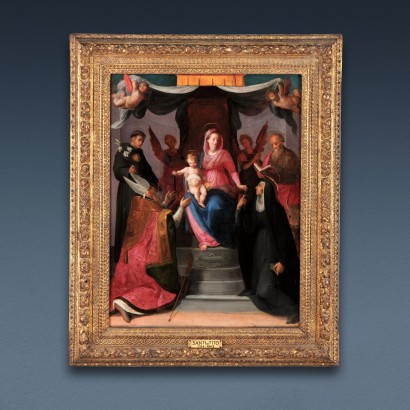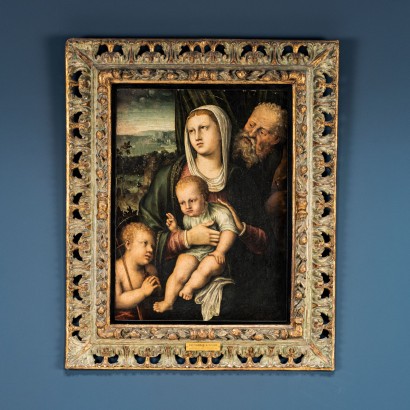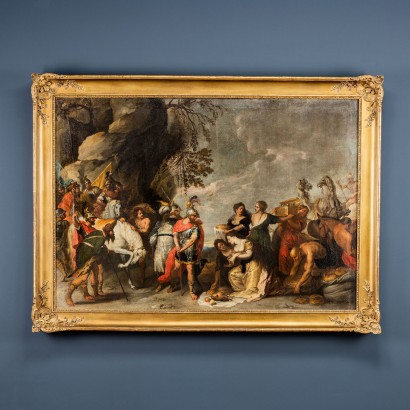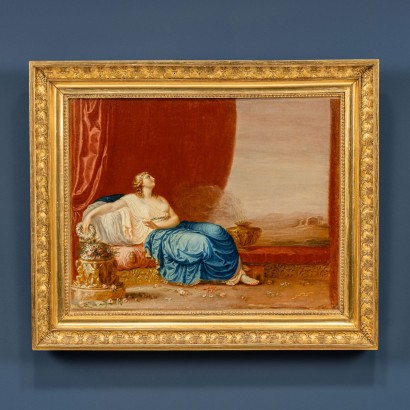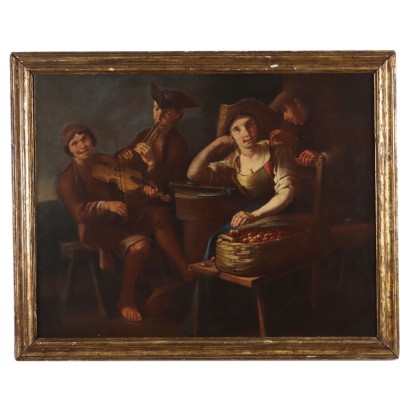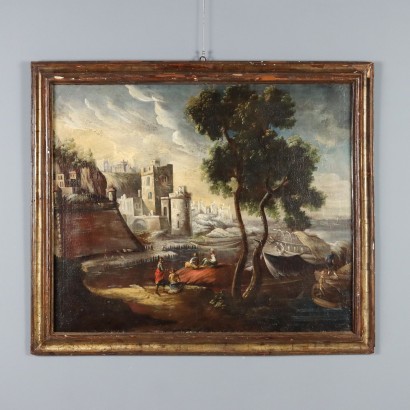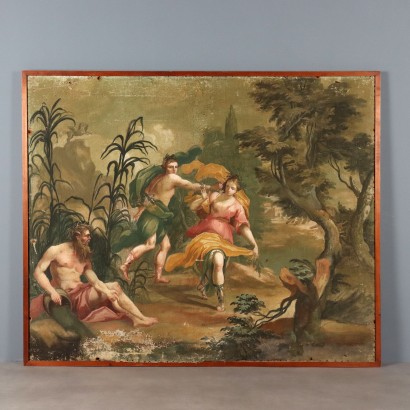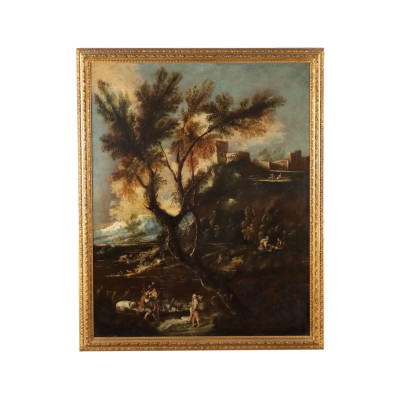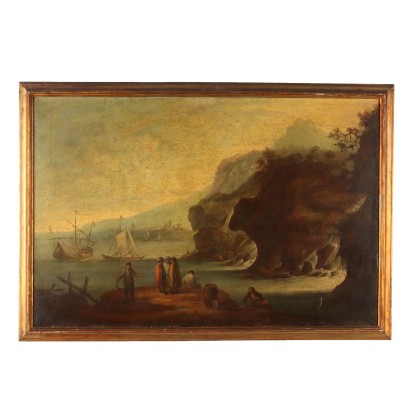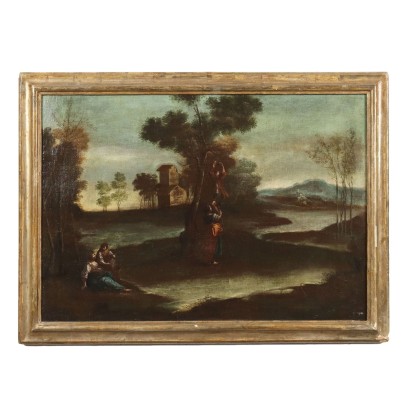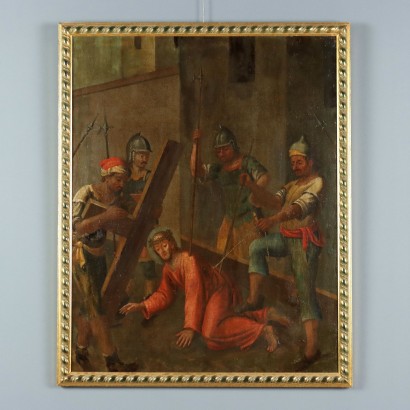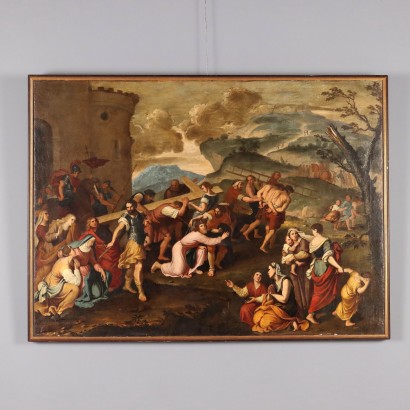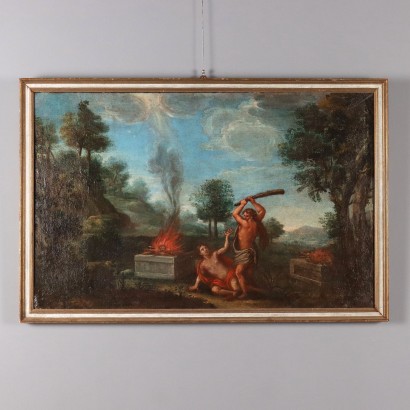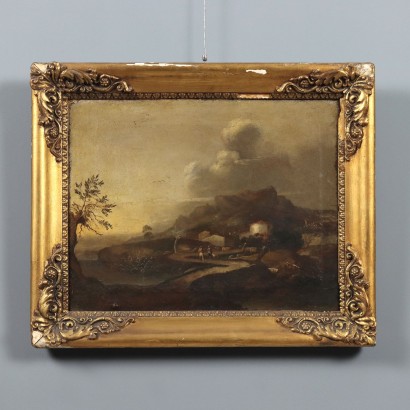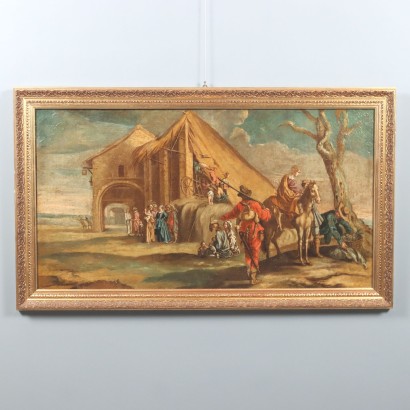Antique Painting Signed Christian Georg Schütz I Landscape '700 - River Landscape with Shepherdess and Ruins
Features
River Landscape with Shepherdess and Ruins
Artist: Christian Georg Schütz I (1718-1791)
Artwork title: Paesaggio fluviale con Pastorella e Rovine
Artistic school: German School
Age: 18th Century / 1701 - 1800
Subject: Landscape with Figures
Artistic technique: Painting
Technical specification: Oil on Canvas
Description : Paesaggio fluviale con Pastorella e Rovine
Oil on canvas. Signed " Schütz fecit" on the ruin to the right of the shepherdess. Christian Georg Schütz the Elder captures an idyllic and serene landscape, crossed by a winding and slow river; on the right bank stand some architectural ruins of classical structures, while in the foreground, seated in the center, serene and composed, a shepherdess spins wool while watching over her small flock of goats and cows. The painting is a hymn to nature, where the naturalistic elements, the earth, the sky, the river meet to form a harmonious and balanced scene, pervaded by pink light, in which the living figures and the architectural remains fit in with balance and calm. Schütz mainly painted river views of the Rhine and the Main, places he inhabited, and worked for important German clients, nobles and prelates. The painting has participated in several art auctions. Restored and relined, it is presented in a period frame.
Product Condition:
Product in good condition, shows small signs of wear. We try to present the real condition as completely as possible with the photos. If some details are not clear from the photos, what is reported in the description is valid.
Frame Size (cm):
Height: 112
Width: 188
Depth: 8
Artwork dimensions (cm):
Height: 95
Width: 172
Additional Information
Artist: Christian Georg Schütz I (1718-1791)
Born in 1718 in Flörsheim am Main, Christian Georg Schütz, or Schüz, called The Elder, studied painting in Frankfurt am Main with Hugo Schlegel, a painter specialized in the decoration of building facades, and continued to work in the same city mainly as an exterior fresco decorator. He continued his studies with the court painter Giuseppe Appiani. In 1762 he went to Switzerland with his artist friends Emanuel Handmann and Johann Ludwig Aberli, a trip documented and dated by the painting Swiss Landscape In 1763 he was deputy head and the following year director of the painters' guild of Frankfurt am Main. In 1767 he was granted permission to establish an Academy of Art. His first patron was Baron Heinrich Jacob von Haeckel, who purchased 40 paintings for his collection. Schütz also worked for William VIII of Hesse-Kassel, executing 15 overdoors, for the Elector of Mainz, Archbishop Johann Friedrich Karl von Ostein, painting 80 overdoors, for Prince Wolfgang Ernst von Isenburg-Birstein and for François de Thoranc. He devoted himself to painting landscapes, urban and topographical views, especially of the Rhine and the Main, but he also painted ancient ruins, floral still lifes and religious subjects. Schütz died in Frankfurt am Main in 1791.Artistic school: German School
Age: 18th Century / 1701 - 1800
18th Century / 1701 - 1800Subject: Landscape with Figures
Artistic technique: Painting
La pittura è l'arte che consiste nell'applicare dei pigmenti a un supporto come la carta, la tela, la seta, la ceramica, il legno, il vetro o un muro. Essendo i pigmenti essenzialmente solidi, è necessario utilizzare un legante, che li porti a uno stadio liquido, più fluido o più denso, e un collante, che permetta l'adesione duratura al supporto. Chi dipinge è detto pittore o pittrice. Il risultato è un'immagine che, a seconda delle intenzioni dell'autore, esprime la sua percezione del mondo o una libera associazione di forme o un qualsiasi altro significato, a seconda della sua creatività, del suo gusto estetico e di quello della società di cui fa parte.Technical specification: Oil on Canvas
The oil painting is a painting technique using powder pigments mixed with bases in inert and oils.Other customers have searched:
Se sei un appassionato d'arte, non perderti i nostri approfondimenti sul Blog Arte Di Mano in Mano e su FineArt by Di Mano in Mano - Arte:
Leggi di più
Ecco alcuni tra i principali articoli:Vedute
Falsi nell'arte antica
Un messaggio di fiducia per ripartire
La potenza espressiva dell'arte figurativa etiope
Breve Storia del Collezionismo
Giorgio Upiglio, maestro dei libri d'artista
Matthias Withoos detto "Calzetta bianca"
San Rocco pensaci tu - Classic Monday
Dai un'occhiata alle nostre rubriche di divulgazione sull'arte:
Epoche
Lavorazioni e tecniche
Mostre ed Eventi
Protagonisti
Se sei appassionato di pittura antica, con tutta probabilità gusterai le schede di questi stupendi quadri:
"Dio parla a Noè dopo il diluvio", Jacopo da Ponte, detto il Bassano, seconda metà XVI secolo
Crocifissione, maestro della misericordia dell'accademia, terzo quarto del XIV secolo
Erminia incontra i pastori, Camillo Gavassetti, Seconda metà anni Venti del XVII Secolo
Eroine dell'antichità, Francesco Conti, XVIII secolo
Hieronymus III Francken, La Negazione di Pietro, XVII secolo
Jefte e la figlia, Girolamo Forabosco e aiuti, XVII secolo
L'Accademia di Platone, piccolo arazzo, fine XVII - inizio XVIII secolo
Maddalena e San Giovanni Battista
Natura Morta, Bartolomeo Arbotori, XVIII secolo
Sacra Famiglia con San Giovannino, Bartolomeo Ramenghi, scuola di, prima metà XVI secolo
Testa Femminile, Andrea del Sarto, ambito di, post 1522
Uva, fichi, melagrana e pesche su un capitello - Maximilian Pfeiler, primo quarto XVIII secolo
Sapevi che l'arte può essere anche un ottimo investimento (e non solo per grandi portafogli)?
L'Arte tra Collezionismo e Investimento
FineArt: Arte come investimento
Product availability
The product can be seen at Cambiago
Immediate availability
Ready for delivery within 2 working days from ordering the product.

